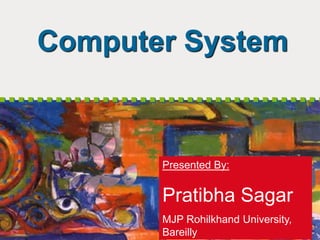
Computer-System-pratibha.pdf
- 1. Computer System Presented By: Pratibha Sagar MJP Rohilkhand University, Bareilly
- 2. A Computer is a programmable electronic machine that performs high- speed mathematical or logical operations, stores & processes data to get meaningful information. Definition of Computer
- 4. Computer Hardware is the physical part of the computer system, the machinery and equipment. Parts of the computer “you can see” Computer Hardware
- 5. Computer Software Computer Software are programs that tell the computer what to do.
- 7. System Unit - the metal box that houses the processor, main memory, and secondary storage devices. – Abbreviated to “CPU” Input and output devices - attached to the system unit via a device controller. – The terms "input" and "output" tell you if data flow is into or out of the system unit. – Abbreviated to “I/O” Parts of a Computer System
- 8. Basic Operations of Computer It accepts data or instructions by any way of input. It stores data. It can process data as required by the user. It controls all operations inside a computer. It gives results in the form of output
- 10. The Components Inside The components inside the CPU are – Mother board – Bus – Cards – Ports – Memory – Hard Disk Drive – Floppy Disk Drive – Power Supply Unit – Computer Clock (Real Time Clock)
- 11. Computer Inside
- 12. An Inside View
- 13. The components inside shows the Bus - transports data between the processor and other components Motherboard - consists of a complex group of circuits Controllers - controls the input/output work in the computer The Components Inside
- 14. Cards - fixed on slots contained in buses to enable the expansion of the computer Ports - entry and exit points of buses The Components Inside
- 15. An Inside View Hard Drive Bus Hard Disk Driver
- 16. Outer View of Computer (Front)
- 17. Outer View of Computer (Back)
- 18. Expansion Ports Jacks or connectors Mouse, keyboard, serial, USB Cables
- 19. Auxiliary (Secondary) Memory Input devices Output devices CPU- Central Processing Unit • Control Unit •Arithmetic Logic Unit (ALU) Main/Primary Memory (RAM/ROM) How these Components Work Together Monitor, Printer Keyboard, Mouse Hard drive CD R/W, DVD, floppy drive, ZIP drive, Flash memory Bus Bus
- 20. Computer Devices that input/provides data to a computer from the outside world Examples Key Board Mouse Scanner Digital Camera Computer Input Devices
- 21. Input Devices
- 22. Input Devices
- 23. The CPU The CPU is Central Processing Unit i.e. “Heart” of Computer System. It is a silicon chip that contains millions of tiny electrical components. The CPU’s three main parts are: – Control Unit – Arithmetic Logic Unit (ALU) – Registers
- 24. Arithmetic / Logic Unit Registers Control Unit Small, fast storage areas for instructions and data Performs calculations and decisions Coordinates processing steps The CPU
- 25. The CPU controls all of the other resources within the system, in order to accomplish a task. Component Interaction
- 26. Any type of device that provides data from a computer to the outside world Examples of output data: – A printed report – An image such as a picture – A sound Common output devices include: – Monitor (display screen) – Printer Output Devices
- 27. Output Devices
- 28. User hits the ‘2’ key then Enter Output 4 on the screen ALU adds 2 + The user input Y = 4 Main Memory Program: INPUT X Y = X+2 OUTPUT Y The performance of the CPU is dependent on both its speed and memory Working of the CPU
- 29. Access to Instructions The hard disk is too slow to provide instructions to the CPU. So programs are first loaded into main memory, which is much faster. The CPU can then access the instructions more quickly.
- 30. Cache Memory But as CPU speeds became faster, the main memory couldn’t provide the CPU with the instructions at a fast enough rate. So even faster memory ( cache memory) is now placed between the CPU and main memory to provide the instructions at quicker rate to the CPU.
- 31. Cache Memory When an instruction or data is accessed from main memory, it is placed in the cache. Second and subsequent use of the same instruction/data will then be faster, since it is accessed directly from the cache.
- 32. User’s View of Computer System
